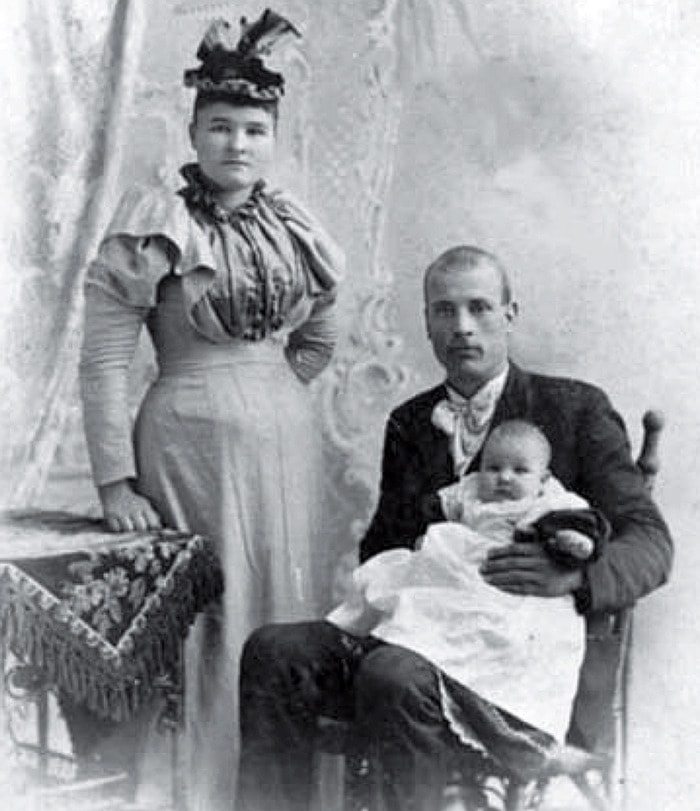Some 20 years ago, when I started my quest for the early history of Whonnock, I decided to meet with Don Waite.
His book, The Langley Story Illustrated, held a wealth of information I wanted to discuss with him. Besides, the book showed a unique picture of Whonnock’s first white settler, the Shetlander, Robert Robertson, and his wife Tselatesenate, alias Mary, from Nicomen.
Don welcomed me warmly and went out of his way answering my questions, sharing his knowledge, and even lending me some of his research material to copy. He also gave me a print of his photo of the original Robertson photograph. The image took pride of place in my Whonnock Notes about Robert Robertson and his family.
It is a photograph of a young couple. The man, in a dark suit, white shirt and well-tied white cravat, is sitting on a chair, with his large hand holding a baby on his lap. The baby is wearing what looks like a white dress, possibly a baptismal gown.
A well-dressed woman is standing on the right side of the man. On her head she has a little rim-less hat decorated with flowers. Her left hand is behind her back. The other hand, closed, is resting on a small table covered with a dark, flowered cloth with long fringes.
The background of the picture is a curtain with a trace of a painted baroque decoration. With this kind of a background any place could be turned instantly into a photo studio.
Back in the 1970s, when Don took pictures of photographs of pioneers to illustrate The Langley Story, he found the Robertson photo with other pictures at the home of Evelyn Copeland in North Saanich.
Evelyn, née Moses, was a granddaughter of Edward Julius Muench, whose wife was a sister of Robert Robertson’s wife. Someone had written “Robertson” on the back of the original photo and the sitters had always been identified as Robert Robertson, his wife, and probably their first-born.
When I met Don, Evelyn Copeland had passed away, and the whereabouts of the Robertson photo and the small collection of Muench family pictures were unknown.
Fortunately, the photographs were found in the custody of a niece of Mrs. Copeland, who let me use the images for my Whonnock Notes about the Muench family. She also graciously allowed me to donate the original photos to the Langley Centennial Museum. However, the Robertson picture went to a direct descendant of Whonnock’s first white settler.
Over time, I became increasingly uncertain about the identity of the people in the picture. There was something in the smartly dressed young couple and their infant that seemed to me at odds with the Robert Robertson I knew from the records – the rather rough boatman from Whonnock and former labourer of the Hudson’s Bay Company. But the family assured me that the photo showed their ancestors.
The dark cardboard backing of the original photo carries the printed name “Thompson” and “New Westminster, B.C.,” separated by a logo formed by three intertwined letters: SJT.
Not long ago it would have taken visits to libraries and archives to find out who that photographer was, but today we have the Internet at our disposal. I found the information on David Mattison’s fabulous web site, “Camera Workers of British Columbia and the Yukon.” The photographer’s name was Joseph Stephen Thompson, and he lived in New Westminster, working in the 1890s.
Sadly, this date confirmed my suspicions: the picture did not show the first white settler of Whonnock and his wife. Robert Robertson settled in Whonnock in the 1860s and his first children were born shortly after that. In the 1890s, Robert was already in his 50s and Tselatetsenate was probably no longer alive since her name does not appear in the 1891 Canada Census.
So this is an image of a different and much younger couple, and we may never know who they were.
This little excursion into the Internet has once again shown me that we can never be careful enough when doing historical research. Every piece of information should be treated with respect, but one should never fail to look for more information to validate it.
This questioning may upset those who firmly believe in what they were told by their parents or relatives or friends or what is written down. But it helps to separate the wheat from the chaff and is an essential step in the process of recording history.
– Fred Braches is a local historian who lives in Whonnock.
